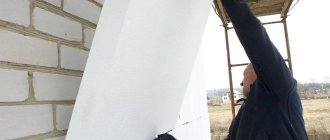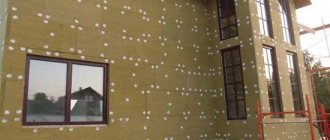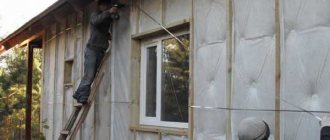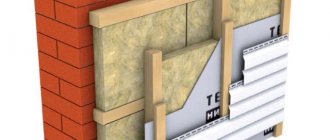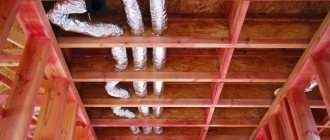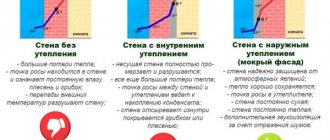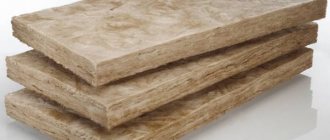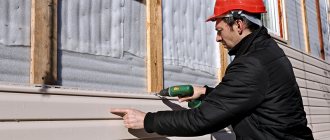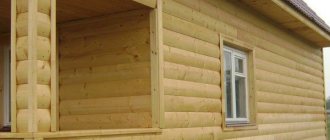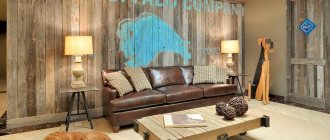The increase in utility tariffs in recent years has been quite large. This is especially reflected in heating prices. People living in private homes were simply forced to look for options that could help reduce costs.
The most optimal solution from a cost point of view is to insulate the walls from the outside, which reduces costs and makes the house more comfortable to live in during cold seasons.
This article will look at the best external wall insulation.
External wall insulation
Rating of the best external insulation materials
| Photo | Name | Rating | Price | |||
| TOP 3 models of expanded polystyrene foam | ||||||
| #1 | KNAUF Therm HOUSE | ⭐ 98 / 100 | Find out the price | |||
| #2 | Knauf Therm Wall Pro | ⭐ 97 / 1001 - voice | Find out the price | |||
| #3 | Knauf Therm Facade PRO | ⭐ 95 / 1002 — votes | Find out the price | |||
| TOP 4 models of extruded polystyrene foam | ||||||
| #1 | Carbon Eco TB | ⭐ 99 / 1002 — votes | Find out the price | |||
| #2 | Ursa XPS-N-III-L G4 | ⭐ 97 / 100 | Find out the price | |||
| #3 | TechnoNIKOL Technoplex | ⭐ 96 / 1001 - voice | Find out the price | |||
| #4 | Penoplex Wall | ⭐ 94 / 1002 — votes | Find out the price | |||
| TOP 5 stone wool models | ||||||
| #1 | Paroc Extra | ⭐ 98 / 1001 - voice | Find out the price | |||
| #2 | TechnoNIKOL Technovent Optima | ⭐ 97 / 1002 — votes | Find out the price | |||
| #3 | TechnoNIKOL TechnoFas Cottage | ⭐ 95 / 1002 — votes | Find out the price | |||
| #4 | Rockwool Facade Butts | ⭐ 94 / 1004 — votes | Find out the price | |||
| #5 | Rockwool Light Butts Scandic | ⭐ 94 / 100 | Find out the price | |||
What external wall insulation would you choose or recommend?
Take the survey
The best way to insulate a house, how to choose the right material
When purchasing insulation for a facade, you must ensure that they are components of the same system. Sometimes when purchasing you will need the help of a professional, because the materials are not always sold as a single set, but must correspond to each other according to such characteristics as:
- vapor permeability;
- frost resistance;
- thermal expansion.
And also when choosing, you should take into account the chemical processes that will occur in a single system. Materials for insulation should be selected not only taking into account the type of frame. In this case, you need to make allowances for the climatic features of the region, architectural characteristics and technical purpose of the building.
The most common materials for facade insulation are mineral wool and polymer insulators.
When insulating the façade of a house from the outside with foam plastic or other material, the continuity of the contour should be maintained. There should be no cracks, gaps or breaks on the façade through which moisture or frost can enter the frame. It is also important to maintain the vapor permeability of the system. Here the main rule is that each subsequent layer from the inside to the outside must have a higher degree of vapor permeability. This is done so that the walls can “breathe” and condensation does not form on the surface.
The cost of facade insulation will depend on what material is chosen for this. The most common are:
- Mineral wool (mineral wool). Belongs to the group of fiber insulation materials. Most often made of fiberglass or basalt fiber.
- Ecowool. Modern insulating material based on cellulose.
- Group of polymer insulators. Polyurethane foam, polyurethane, expanded polystyrene.
- Bulk radiators – expanded clay, vermiculite.
- Natural traditional materials - dry leaves, reeds, straw, sawdust, pine needles, which can be used together with clay.
When insulating the façade of a house from the outside with polystyrene foam, the continuity of the contour must be maintained; there should be no gaps, gaps or breaks.
TOP 3 models of expanded polystyrene foam
Knauf Therm Facade PRO
Knauf Therm Facade PRO
Main properties:
- coefficient (k-t) of vapor permeability of the material – 0.026 mg/m*h*Pa;
- thermal conductivity of the material – 0.038 W/(m*K);
- degree of flammability – G3;
- density – 17 kg/sq.m.
The top three should start with the Façade model from the German company Knauf. It is implemented in the form of rectangular slabs. Thanks to a special production technology, the manufacturer will eliminate shrinkage of the slabs not only during, but also after installation.
This material is proposed to be used for insulating the walls of a private house, summer cottage, as well as various non-residential premises.
Excellent moisture resistance indicators will allow this material to be used in any, even the most humid, climatic conditions. Environmental friendliness and compactness are two more criteria why this model is worth paying attention to.
pros
- good quality of the final product
- environmentally friendly material that is not harmful to health;
- excellent heat-shielding properties;
- light weight;
- moisture resistant.
Minuses
- not detected.
Knauf Therm Facade PRO
Knauf Therm Wall Pro
Knauf Therm Wall Pro
Features:
- vapor permeability value of the material – 0.026 mg/m*h*Pa;
- thermal conductivity of the material – 0.042 W/(m*K)
- flammability group – G3;
- density – 12 kg/sq.m.
Next is another model of the Therm series. Energy-efficient boards are made on the basis of polystyrene foam, taking into account all the strict requirements established by the German company. This material has not only high strength, but also obvious hydrophobic properties. They will provide good insulation for private houses, summer cottages and office premises.
This insulation model is usually used for thermal insulation of a three-layer brick wall. The slabs from this company are laid after laying two layers of brick, and only after that the third layer of brick can be installed as a finishing touch.
Important! In addition to a brick wall, this model can be placed on reinforced concrete panels.
Environmental friendliness and safety are the main principles used by the manufacturer when creating these slabs. They contain no toxic or flammable reagents - only natural ingredients.
pros
- does not sag;
- environmentally friendly material;
- does not change shape even after time;
- has high heat-protective properties;
- moisture resistant.
Minuses
- not detected.
Knauf Therm Wall Pro
KNAUF Therm HOUSE
KNAUF Therm HOUSE
Characteristics:
- vapor permeability value of the material – 0.032 mg/m*h*Pa;
- thermal conductivity of the material – 0.042 W/(m*K)
- flammability group – G3;
- density – 10 kg/sq.m.
This universal insulation from Knauf is perfect for a private home or summer cottage. It is made from environmentally friendly polystyrene foam, which does not contain flammable or simply harmful elements. They insulate roofs, external walls, attics, interfloor ceilings and even floors.
pros
- versatility;
- environmentally friendly material;
- high heat-shielding properties;
- moisture-resistant material;
- withstands loads of up to 7 tons per 1 m².
Minuses
- not detected.
KNAUF Therm HOUSE
How to avoid mistakes when insulating walls?
The cause of all errors is a lack of information about the technology and a poor understanding of the meaning of the actions performed. Therefore, you should study the issue as completely as possible, find out all the nuances of vaporization and finding the dew point.
In addition, it is necessary to carefully analyze the technological processes used to insulate walls in given conditions and on a given material, clarify all weak points and find out the most effective ways to eliminate them. Only after this should work begin.
Dew point
External thermal insulation of walls is the most successful and effective procedure . The main condition for success is the correct choice of material and possession of the necessary knowledge, skills or other information. This approach guarantees high-quality and reliable insulation of external walls, creating a cozy atmosphere in the house.
Why is external insulation better than internal insulation?
Insulation of the house has always been considered an important aspect: without this, the house will not be warm in the winter, nor will it be possible to enjoy the cold in the summer. Houses are usually insulated from the outside. The standards are specified in SP 23-101-2004.
Internal insulation options have one very unpleasant point - they take up free space in the room. Of course, the document does not prohibit insulating a house from the inside, but this should be done only in extreme cases, when it is simply impossible to insulate the outside.
Insulation from the inside, in addition to reducing free space, carries another disadvantage - rapid failure due to exposure to moisture, so most often when insulating the inside of a room, another layer is installed - a vapor barrier.
The result of the comparison is as follows: it is better to insulate a house from the outside than from the inside.
When is it better to insulate the exterior of a house?
Before insulating a house, you need to know that you can begin any facade work only after the remaining construction and repair work has been completed, this includes:
- roof installation;
- performing external waterproofing of the foundation;
- installation of window and door openings;
- securing the ventilation system and other utilities.
You can begin to insulate the facade of the building only after the remaining construction and repair work has been completely completed.
Many experts argue that insulation of building facades is necessary only after the house has undergone complete shrinkage and has completely dried out after construction. Otherwise, there is a high probability that the finished facade will become covered with cracks and lose its neat appearance.
Before insulating your house, you should make sure that severe heat or frost is not expected. It is best to wait until the temperature remains constant above zero during the day. The optimal time is considered to be the end of spring or the beginning of autumn, when the temperature ranges from +5 to +25 degrees. Many people recommend that before starting facade insulation, complete all internal work that is accompanied by the release of condensate, such as organizing screed and pouring the floor.
Insulating the façade of a wooden house or building made of any other material from the outside should begin after a careful inspection of the entire surface. If you have no experience in carrying out construction work, it is better to entrust this task to a specialist who will perform the required tests and check the surfaces of external walls for the adhesion of the adhesive composition used for installing the insulation. As a result of the work carried out, the load-bearing capacity of the walls will become clear, and the maximum load that will arise as a result of fastening will be calculated.
On a note! In addition to the fact that it is important to choose the right material for mounting on the walls, it is also necessary to maintain the facade insulation technology in order to prevent the appearance of so-called cold bridges, as a result of which the insulation can collapse or delaminate.
The optimal time of year to begin work on façade insulation is considered to be the end of spring or the beginning of autumn.
It is important not only to carry out insulation, but also to choose modern and high-quality insulation that is most suitable for a particular building. The insulation must not only be vapor- and water-permeable, but also heat-resistant to avoid accidental fire and rapid burning. It is best if the material is environmentally friendly, and the load-bearing walls are protected from the penetration of fungi and other microorganisms that can destroy the frame, especially if it is made of natural building materials.
Pros and cons of external insulation
Insulating the exterior is a useful method of retaining heat and reducing costs in the long run.
This option has both advantages and disadvantages, which should be equally taken into account. Let's look at them below.
| pros | Minuses |
| The room remains warm longer, which is important in the winter season | It takes longer to warm up the house due to the thermal insulation properties of the material |
| The temperature inside the house does not change, and if it changes, it is insignificant | |
| The insulation closes the seams in panel houses, which solves the problem of their sealing | It is very difficult to insulate a multi-storey building on your own - you need to seek the help of specialists |
| Insulation will greatly increase the service life, since the outer material will act as a protective layer |
External insulation has its pros and cons, which should be taken into account when choosing
Why external thermal insulation?
Insulating walls outside is the most popular option. The complex of works includes preparing the walls, covering them with the selected insulation, as well as decorative finishing. Prices for gas and electricity are rising, so reducing heat loss will save on utilities.
But why external wall insulation? There are several reasons for this:
- Since the layer of insulation with decorative finishing will be located outside, the usable area of each room will not be lost. This is especially true for small rooms, such as a bath or hallway.
- Externally, walls are exposed to the negative influence of moisture, wind, temperature fluctuations and others. Insulating a private home and finishing the outside will help protect them. This will allow them to last much longer.
- The walls will not freeze or become wet due to the shift in dew point.
- Insulation materials will not only serve as thermal insulation, but will also not allow sound to pass into the house.
Thanks to all these features, external wall insulation has been and remains the best way to keep heat inside.
They try to make materials for external wall insulation safe, but not all of them are completely free of toxic substances. The thermal insulation material will be located outside, so it will not affect human health in any way.
Commonly used insulation materials for outdoor use
Construction stores today offer a wide range of thermal insulation products. The three most popular materials are:
- expanded polystyrene foam (international designation - EPS);
- extruded polystyrene foam (international designation - XPS);
- stone wool.
Expanded polystyrene foam
It is considered a fairly popular option. Presented in the form of solid slabs. Their density can be different, which directly affects thermal conductivity.
The structure of this material is small balls with air inside, which are tightly fastened together, which provides excellent thermal insulation in the house.
Foamed polystyrene foam has good moisture resistance and strength. Also considered low flammable.
And yet this material has disadvantages. There are only two of them:
- when burning, it can release large amounts of toxic gas;
- they cannot insulate walls made of “breathable” material.
Example of expanded polystyrene foam
Extruded polystyrene foam
This material has some similarities with expanded polystyrene foam in terms of composition. The difference is in the production technology, thanks to which this material has a cellular structure.
In terms of home insulation and water absorption, this material is superior to expanded polystyrene foam.
Important! This material also stands out for its greater strength and lower vapor permeability.
It is precisely because of the properties of this material that it is used to insulate a house from the outside, although the disadvantages of it and the foam version are exactly the same.
Example of extruded polystyrene foam
Stone (so-called basalt) wool
The third most popular type of building material is basalt wool.
The design of the slab hints at reduced thermal conductivity. The reason for this is the structure - it is fibrous and has a low density. Such material, interestingly, is not exposed to fire or decay. Interestingly, it is considered “breathable,” which means it allows air to pass in or out, preventing the appearance of fungus.
Example of stone wool
Important! This wool has a “relative” in the form of glass wool, but it is used less often as insulation.
Mineral wool for external surfaces
Walls outside houses can be insulated using this roll material. At a low price, it has good insulating properties. The industry produces several types of this insulation:
- glass wool;
- slag wool, made from waste from open-hearth furnaces;
- rocks serve as the basis for the production of basalt wool.
This is the most inexpensive material for thermal insulation of external walls. To impart better chemical and performance properties, the slabs are treated with special substances. Polymer impregnation is used to give the material water-repellent properties.
Other external insulation materials
Today, in addition to the above options, you can find alternative insulation options in construction stores:
- polyurethane foam;
- "Teplover"
- ecowool;
- liquid ceramic insulation.
Polyurethane foam
This material is a familiar polyurethane foam. As a rule, it is used to seal cracks during the construction of building structures.
Polyurethane foam (another name is PPU) is a good option when the task is to insulate a house and create a seamless surface.
It is worth noting that it is better not to install such material yourself - this should be entrusted to specialists who will carry out high-quality work on insulating the outside of the house using special equipment.
Important! Previously, only professional equipment was used to apply such material, but now it can be bought in the form of an aerosol that anyone can handle.
pros
- absence of seams and joints - fastening such material allows you to achieve maximum integrity of the insulating structure, therefore the chance of seams and joints appearing is minimal;
- versatility - polyurethane foam “sticks” well to almost any material, from wood to concrete;
- long service life - deterioration of properties of polyurethane foam appears at least after a quarter of a century;
- self-extinguishing - this material has a very low flammability rate, which means it will not be able to maintain combustion.
Minuses
- poor holding power.
Polyurethane foam is a fairly popular material used as insulation.
Ecowool
Quite an interesting material that can be used for insulation. It stands out for its naturalness: 80% - cellulose, 20% - boric acid/borax.
Ecowool is applied in three different ways:
- Manual.
- Mechanized.
- Wet styling.
In the first case, such cotton wool is applied using improvised tools. The second option involves the use of a blow molding unit. The third requires the application of an adhesive binder and cellulose wool using a special nozzle and a water supply unit.
pros
- environmental friendliness - the material will not harm health because it is natural;
- ease of preparation - you just need to stir everything and the material is ready for application;
- ease of installation - even a beginner in the field of repair and construction can cope with the application.
Minuses
- not detected.
Ecowool - natural high-quality material for wall coverings
Teplover
It is considered a relatively new material. It is a plaster made on the basis of minerals such as vermiculite and perlite. The mixture stands out because, in addition to thermal insulation properties, it also has sound insulation properties.
This material has advantages and disadvantages that are worth considering.
pros
- durability;
- ease of preparation;
- high reliability;
- allows the wall to “breathe”;
- non-flammability - can withstand temperatures of more than 1000 degrees Celsius.
Minuses
- price – such material is quite expensive;
- complex application technology.
Important! It may be difficult to insulate a house with such a mixture on your own, so insulation with Teplover should be done by professionals with special equipment.
Heatover is a modern development that will satisfy the needs of most buyers
Liquid ceramic insulation
This type of thermal insulation can be used not only inside, but also outside the house. Externally, it is a liquid suspension (in some cases even a paste), resembling acrylic paint in consistency and appearance.
The basis of “liquid insulation” is a water-acrylic mixture. It is not only distributed evenly, but also spreads in a thin elastic layer over the entire surface.
The most important component of this suspension is ceramic spherical microgranules, the voids of which are filled with vacuum. It is these granules that provide not only heat preservation, but also a reduction in heat loss.
Important! Liquid insulation is somewhat reminiscent of a thermos in its functions.
In addition to granules, the water-alkyd mixture includes silicone, rubber and other additives. They will strengthen the insulation and reflect IR and UV radiation.
Let's consider the pros and cons of the material.
pros
- unable to burn;
- relatively environmentally friendly material;
- It is quite easy to apply due to the liquid form of the insulation.
Minuses
- The cost of this type of insulation is quite high.
Liquid insulation is the most technologically advanced and fresh variation of thermal insulation
Characteristics and review of the best thermal insulators
Everyone wants to do all the work cheaply, but so that the result remains at a high level. Thanks to the availability of various options for thermal insulation materials for external walls, consumers have the opportunity to purchase products for a certain amount and with certain characteristics. Let's consider the most popular options for insulating the exterior of a house:
- Mineral wool.
- Foam and EPS.
- Cellulose type insulation.
- PPU (polyurethane foam).
- Bulk type insulation.
Technical characteristics, installation process and other features of facade insulation vary. There is no one universal option for all occasions, so you have to choose.
cotton wool
Natural, pure, environmentally friendly material, which consists of the finest fibers. These fibers are formed during glass processing at elevated temperatures and its spraying. The same fibers are made from rocks and slag. The fibers are arranged in different ways, due to which the structure is divided into the following types: corrugated type, vertically layered, horizontally layered. The dimensions and density of the insulation also change. It all depends on the production technology. After insulation, you get breathable, warm walls.
Mineral wool is named because mineral substances are used to create it. They are used to insulate walls inside and outside the house.
Features of each type of cotton wool:
- Glass wool is characterized by high resistance to chemical attack. She is not afraid of temperatures up to 500 ℃.
- Stone wool is made from basalt rocks of the igneous type. It is commercially known as basalt wool. Features high density, rigidity and better performance. The material survives critical temperatures up to 600℃. Exterior insulation with stone wool is in great demand.
- Slag wool is made from melted metallurgical waste. Its resistance to heating is lower, 300℃. It has the highest hygroscopicity.
Both mineral slabs and rolls are available for sale. Advantages of a heat insulator:
- The structure of the material is fine-fiber, due to which air and steam pass freely through the insulation. Condensation will not form on the surface.
- The material will not burn and serves as an additional fireproof layer.
- It has excellent heat and sound insulation qualities, the noise of the street will not be heard, and warm walls will save on heating costs.
- No microorganisms, insects or rodents will damage the structure of the heat insulator.
- Insulation for the outside of a home is light in weight. It is easy to transport, easy to work with, and does not overload the structure of the house.
Flaws:
- The material may shrink. At low densities, deformations occur clearly. Only if you insulate the walls from the outside with basalt slabs, the shrinkage will be minimal, but the price of the product is much higher.
- When exposed to moisture, mineral wool loses its properties and takes a long time to dry.
- When working with the material and laying it, harmful particles from the fibers are formed, which can settle on the skin, penetrate the mucous membranes and cause discomfort. Therefore, insulation of the walls of a house from the outside is carried out using protective equipment: a respirator, goggles, gloves, a suit or overalls.
The most famous and reliable manufacturers are the following brands: ROCKWOOL, URSA GEO, Knauf, Isover.
Polystyrene foam and extruded polystyrene foam (EPS)
No less popular are polystyrene foam-based insulation materials for exterior walls of a house. Their peculiarity is their closed cellular structure. 98% of the heat insulator consists of air and inert gas. They are in sealed cells. This makes the material very light. Another feature is that foam plastic is not afraid of moisture. It is often used to insulate exterior facades, basements, foundations and basements.
Advantages of polystyrene foam and EPS:
- The slabs are easy to handle, carry and install. For a beginner, this is the best facade insulation for the exterior of a house.
- When wet, the foam does not lose its properties, since it does not react with it in any way. Fungus and mold are also not scary for him.
- If you follow the work technology, then warm walls will remain like this for 50 years, especially if we talk about XPS.
- The products are not afraid of soap and salt solutions, bleach and other chemicals.
- No protective equipment is required for installation.
- Excellent sound and heat insulation performance.
- Low cost.
Disadvantages of wall insulation:
- The material is vapor-impermeable, does not allow moisture to pass through and is not suitable for thermal insulation of walls with vapor-permeable characteristics.
- Solvents such as acetone, drying oil, and varnishes can completely destroy the foam. In addition, he is afraid of exposure to UV rays.
- It melts at elevated temperatures and begins to release harmful substances.
- Insects and rodents love to damage polystyrene foam.
The Russian market is full of different product manufacturers. The best manufacturers of EPS are Penoplex and Teplex. And it is better to choose polystyrene foam from the products GREENPLEX, Ursa, PRIMAPLEX.
Cellulose type insulation
This group includes ecowool, which is 80% made from wood fibers or cellulose. The remaining 20% are antiseptics, which protect the material from rotting, and fire retardants, which protect against fire. Unlike previous options, ecowool is a representative of crumbly or sprayed materials for insulating external walls. All voids and irregularities are blown out with raw materials, creating a dense protective layer. The installation process can be performed in two versions: dry and wet-adhesive.
Important! Ecowool insulation technology involves the use of special equipment. But sometimes the raw materials are poured manually.
Advantages of ecowool:
- Ecological cleanliness.
- Excellent sound and heat insulation qualities.
- Fire protection.
- Protection against insects, fungi and bacteria.
- Long service life.
Flaws:
- Shrinks.
- It has a high cost.
- The work will require special equipment, since it is difficult to do everything manually.
- Before insulating a wall, it is important to protect the material from moisture, since it is highly hygroscopic.
Important! There are other representatives of bulk type heat insulators. These are expanded clay, perlite sand, foam chips, vermiculite, sawdust.
PPU (polyurethane foam)
Representative of a new generation of materials. This is a liquid polymer substance, which, after spraying onto the surface, becomes solid and increases in size (like polyurethane foam). The structure is cellular. After working with the insulation, a monolithic layer is created on the surface. The spraying process requires special equipment.
Exterior insulation with polyurethane foam has the following advantages:
- Thanks to the spraying method, the mixture gets into the most inaccessible places, filling all the empty space.
- It has some of the best heat and sound insulation qualities.
- Resistant to chemicals, not afraid of water and withstands sudden temperature fluctuations.
- Application is possible on any surface: warm wooden walls, brickwork, concrete walls and metal.
- Has little weight.
- The operating period is 30 years or more.
Insulating the outside of polyurethane foam walls also has its disadvantages:
- When exposed to UV rays, unprotected insulation begins to deteriorate.
- The vapor permeability of polyurethane foam is low.
- The installation work is complex and beyond the capabilities of a beginner.
- It is possible to insulate PPU walls only if you have special equipment, consisting of a compressor, supply cylinders, a hose system and a nozzle.
These were popular variations on how to insulate a house from the outside. They are all unique and have their own positive and negative qualities, so it is impossible to say which is better.
About the choice of insulation - just a complicated matter
You need to choose insulation depending on two factors: what the wall is made of and what the finishing will be.
Let's look at the main options below.
Brick walls
Wet facade
Clause 8.5 of SP 23-101-2004 says the following: vapor permeability of the inner layer (insulation) < vapor permeability of the outer layer (finishing). In other words, the insulation has one task - to help the walls ventilate moisture.
The best option in this case would be mineral wool. The reason for this choice is high vapor permeability. An alternative option would be polystyrene foam + a layer of plaster, since brick walls are not very good at removing moisture.
Facing brick
If for the finishing treatment of brick walls the choice fell on facing brick, then you can use expanded polystyrene in its two variations and stone wool.
Important! If stone wool is used, then you need to create a small but ventilated air gap. In this case, the water will evaporate, and the walls will not get wet.
An example of laying thermal insulation on a brick wall with facing brick finishing
Ventilated facade
If you don’t use facing bricks for cladding a brick wall and don’t make a wet facade, then you should take a closer look at the advice of professionals. They may suggest using porcelain stoneware in the form of large slabs. You can also use wall panels as a finishing treatment. In addition, it is often suggested to use stone wool as insulation.
An example of laying thermal insulation on a brick wall with a ventilated façade finish
Thermal insulation using “Ventilated facade” technology
This method of external insulation is universal and suitable for all types of reinforced concrete, stone and wooden houses. The exception is frame buildings and cottages made of SIP panels, in which the insulation is laid inside the wall.
Let us list the differences between a ventilated curtain façade and insulation using the “wet” method:
- no wet processes, the heat-insulating layer is attached to the insulated surface only with disc-shaped dowels;
- waterproofing (also known as wind protection) is provided by a special membrane that allows moisture to pass in one direction - from the inside to the outside;
- an air gap of 50–100 mm wide is provided between the external finish and the insulation;
- the facade cladding is mounted on a subsystem - a metal or wooden frame;
- you can choose the appropriate facing material - siding (metal or vinyl), aluminum composite panels, corrugated sheets, porcelain tiles, various artificial stones.
Scheme of a ventilated facade system designed for cladding with composite panels
Important point. The insulation is made of porous materials that are highly permeable to water vapor - mineral wool based on basalt or fiberglass. Density – from 80 kg/m³. Polystyrene foam or polystyrene foam is not used.
“Ventilated facade” insulation works like this: in winter, water vapor, trying to leave the room, passes through the wall, the thickness of the mineral wool and the waterproofing membrane. Once in the ventilation gap between the outer skin and the insulation, the steam is carried away by air currents.
Moisture from the outside does not penetrate the thermal insulation layer, so the cotton wool does not get wet. How it works, watch the video:
As a rule, the price of materials for ventilated systems is higher than building materials for a “wet” facade. We suggest considering the cheapest insulation option – mineral wool + vinyl siding.
Procurement of materials
The calculation of components is based on a document developed by a well-known manufacturer of fiber insulation - URSA. So, for 1 m² of insulated surface you will need:
- non-flammable basalt (or glass wool) insulation in slabs – 1.05 m²;
- siding panels – 1.15 m²;
- docking strip – 0.22 pcs.;
- galvanized metal profile T-shaped – 0.22 linear meters;
- the same, L-shaped – 0.84 lm;
- wall bracket – 1.12 pcs.;
- paronite gaskets – 1.12 pcs.;
- diffusion windproof membrane – 1.2 m²;
- driven dowel – 1.12 pcs.;
- disc dowel in the form of an umbrella – 7 pcs.;
- self-tapping screw – 16 pcs.
Note. The list does not include additional elements - flashings, decorative corners, slope cladding panels. Their number depends on the architecture of the house and is calculated individually.
The list is compiled for a finished subsystem made of galvanized steel. To install an insulated facade covered with porcelain stoneware, more rigid stainless steel profiles are used. The cost of such systems is significantly higher.
Installation diagram of a ventilation façade under siding, insulation – non-flammable mineral wool
In order to reduce the cost, homeowners often practice this option: instead of a steel frame, wooden blocks are directly attached to the walls at intervals of 580 mm, and mineral wool slabs are placed between them. This is also possible, but the effectiveness of thermal insulation is noticeably reduced, since wood conducts much more heat than mineral wool.
Installation of a ventilated system
Insulation using the “dry” method is easier compared to the “wet” facade. The insulation is fixed on the frame brackets, then attached to the wall with disc-shaped dowels; no solutions are used. An important nuance: the subsystem is mounted specifically under the cladding (siding, lining, porcelain tiles, etc.), and not under the dimensions of the thermal insulation slabs.
The installation of a ventilated facade under plastic siding is carried out in the following order:
- We mark the mounting points of the brackets for the vertical guides on the wall. We start from the corner, maintaining a distance of 45–50 cm between the points. The last brackets should be mounted on the opposite corner of the wall, so the indicated interval can be increased or decreased by 5–10 cm.
- We install the brackets, screw U-shaped extension profiles to them. To eliminate cold bridges, we place paronite gaskets under the bracket platforms.
- We lay the thermal insulation layer, making slots in the wool slabs for the profiles. We fix the insulation with dowels. Installation can be carried out in any convenient direction - from below, from above, from the side.
- We stretch the superdiffusion membrane sheets horizontally, starting from the bottom. Carefully place the film on the brackets with a slight tension, first making slits with a knife. The next fabric is stretched with an overlap of 15 cm over the previous one; it is not necessary to glue the joint.
- We press the membrane to the thermal insulation with several disc-shaped dowels. We leave an overlap of 10...15 cm at the top and bottom and wrap it behind the insulation.
- We fix the first and last vertical plank on the wall, bringing them into one plane using a level. If the wall is long, install 1–2 intermediate guides.
- Focusing on the first planks, we mount the remaining vertical profiles. If the racks have to be joined from 2-3 parts, leave thermal gaps of 6-7 mm between the ends.
- Using horizontal jumpers we form corners, window and door openings. Then we cover the façade with siding using standard technology, which is described in great detail in the video (below).
Note. Correct installation of the waterproofing membrane - with the logo facing out. If there is no logo, a special mark is placed on the front side of the film.
When installing the frame, a ventilation gap of 50...100 mm wide should be provided using bracket extensions . If you plan to lay siding panels vertically, then install the profiles horizontally.
Installation diagram of siding and additional elements in window openings
We carry out insulation with mineral wool according to the following rules:
- adjacent slabs are mounted close to each other, the maximum gap is 2 mm;
- vertical joints between the slabs should not coincide, the top row is laid offset relative to the bottom;
- jagged bandaging is done at the corners of the building;
- At the end of the row, you cannot add narrow strips of insulation - attach a solid slab at the corner, and insert the missing piece in the middle.
Advice. It is better not to insert narrow strips of cotton wool at all, since they cannot be attached to the surface. Adjust the dimensions of the last slabs so that there are no such inserts.
Under artificial stone or decorative panels, the frame is mounted in the same way. Only the profiles are installed at different intervals, and clamps are used to hang the tiles. The technology of ventilated insulation under siding is shown in the training video:
Walls made of aerated concrete blocks
Wet facade
According to paragraph 8.5 of SP 23-101-2004 and taking into account the fact that the wall is made not of brick, but of aerated concrete blocks, it would be better to use stone wool. If the premises are well ventilated from the inside, then polystyrene foam can be installed.
Facing brick
When a wet facade is not satisfactory, you can choose another option - facing bricks. Then not only stone wool, but also polystyrene foam can act as insulation.
Important! If you choose stone wool, then you simply need to install a ventilation gap between the facing brick and the insulation so that the moisture evaporates.
An example of laying thermal insulation on an aerated concrete wall with facing brick finishing
How to choose insulation depending on the wall material
If earlier there were not many options for creating buildings, today there are many materials for building walls. They are made from brick, wood, concrete, sip panels, foam concrete and other blocks. The peculiarity is that they are characterized by their thermal conductivity and other properties. Therefore, when answering the question of how you can insulate a house from the outside, you need to clarify what this house is made of. Each insulation has its own characteristics and heat conductivity coefficient.
Let's consider how to insulate the walls of a house from the outside:
| Type of heat insulator | Wall construction material |
| Mineral wool | · Wood; · Ceramic block; · Brickwork; · SIP panels; · Thermal insulation blocks, such as foam block, sibit, gas block, cinder block. |
| Polystyrene foam/expanded polystyrene (EPS) | · Concrete; · Thermal insulation blocks; · SIP panel; · White brick. |
| Polyurethane foam (PPU) | · Concrete. |
| Glass wool Ecowool Basalt wool | · Wood; · Brick. |
| Penoplex | · Brick; · Ceramic blocks. |
Please note that the options described are only recommendations. But everyone decides for themselves which option to use. There are simply reasons for this. For example, why is it recommended to insulate wood, ceramic blocks, and bricks with mineral wool? Sip panels and thermal insulation blocks? These materials breathe, allow moisture to pass through, and an ideal microclimate is formed inside the house and there is no condensation. Basalt wool is insulation for the outside walls of a house, which also breathes. Air will move freely through the walls.
If you choose expanded polystyrene, this will give you a wide choice when finishing; you can not only install a ventilated facade, but also plaster the surface directly over the insulation.
Each type of heat insulator has positive and negative sides, so everyone decides for themselves which material is best to insulate the house from the outside.
Voting: the best external insulation for walls
What external wall insulation would you choose or recommend?
KNAUF Therm HOUSE
0.00% ( 0 )
Knauf Therm Wall Pro
5.88% ( 1 )
Knauf Therm Facade PRO
11.76% ( 2 )
Carbon Eco TB
11.76% ( 2 )
Ursa XPS-N-III-L G4
0.00% ( 0 )
TechnoNIKOL Technoplex
5.88% ( 1 )
Penoplex Wall
11.76% ( 2 )
Paroc Extra
5.88% ( 1 )
TechnoNIKOL Technovent Optima
11.76% ( 2 )
TechnoNIKOL TechnoFas Cottage
11.76% ( 2 )
Rockwool Facade Butts
23.53% ( 4 )
Types of material used for wall insulation
There are two main types of materials used in the production of wool - glass and mineral. Glass wool is made by cooking cellulose with the addition of other ingredients. Mineral wool is obtained by melting rocks, it is also called stone or basalt. Glass wool is non-flammable, vapor permeable and flexible, suitable for all non-stressed and non-slip structures, such as inclined walls, various cavities and gaps, even ceilings.
In the production of cotton wool, materials such as glass and mineral are used.
It is a little more difficult to use stone wool for facade insulation due to the fact that it is heavier than glass wool and less elastic, but the material provides ideal thermal insulation of the outer cladding of the building. Any façade wool should always be glued to a dry and solid base.
When insulating a facade with mineral wool, the following types of material are used:
- Transverse fiber orientation. Suitable for façade systems where heavier tiles will be used. The material has high tensile strength.
- Longitudinal fiber orientation. Designed for application to external walls and contact insulation systems.
Due to its good characteristics and low flammability, cotton wool can be used in conjunction with any materials. It is popular to insulate the exterior of the house with mineral wool under the siding; in this case, you will be able to get both a thermally efficient and beautiful house.
Any type of facade wool must always be glued to a solid and dry base.
How to calculate the thickness of insulation
Calculating the thickness of insulation is not an easy task.
First, the thermal resistance of the outer wall is determined using the formula:
R ex.=(1/α (in)) + R1 + R2 + R3 + (1/α (n))
R1, R2, R3 are the heat transfer resistances of all layers of the wall (we conventionally assume that there are three of them, although in practice there may be more or less).
α(в) and α(н) - the amount of heat transfer from the inner and outer surface of the wall, respectively.
Then the minimum value of thermal resistance is calculated using the formula:
R min = δ/λ δ—layer thickness.
λ is the thermal conductivity of the material.
After this, the results obtained should be compared. If Rmin is less than (or equal to) Rpr, then the wall does not need insulation. If it turns out the other way around, the minimum value is greater than the calculated value, then the difference - ΔR - is the determining value for determining the thickness of the insulation (δS), which is found by the formula:
δS = ΔR · λу, where λу is the thermal conductivity of the insulation.
The calculation method is quite complicated due to the need to look for specific data and values for each region, use SNiPs or other reference materials. All this is quite difficult for an unprepared person, which gives rise to errors that reduce all efforts to nothing.
It’s easier to turn to online calculators , which will quickly give the required value; you just need to enter a few data on the wall material and the selected insulation.
If you have absolutely no desire to engage in such calculations, then you can resort to the simplest (and most commonly used) method: simply use insulation 5 cm thick. This value is the most common, it is suitable for almost all regions (with the exception of the northern ones or those characterized by severe frosts).
